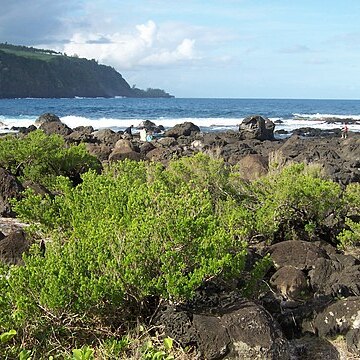Shrubs to densely branched, small trees, maritime; all parts densely covered by grayish silky trichomes. Leaves opposite, sessile or subsessile. Flowers axillary, solitary or paired, 6-merous, actinomorphic, distylous. Floral tube turbinate, 12-ribbed; sepals short; epicalyx segments present, ca. 1/2 as long as or equaling sepals. Petals white or pale pink. Stamens 12, scarcely biseriate, inserted somewhat above base of floral tube, 6 exserted in short-styled flowers, all included in long-styled flowers. Ovary vestigially 3-or 4-locular, appearing 1-loculed with free, central placentation. Capsule dry, circumscissile, slightly exserted at maturity. Seeds irregularly obpyramidal, wingless.
Shrubs or trees. Leaves opposite; stipules vestigial. Flowers solitary, axillary, regular, 6-merous. Hypanthium campanulate, striate; appendages reduced. Ovary with 3 carpels. Capsule slightly exceeding hypanthium.
Stamens 12–18, 2-or 1-seriately inserted a little below the middle of the calyx-tube, subequal or alternately unequal; filaments filiform; anthers broadly elliptic.
Capsule subglobose, ± enclosed in the calyx-tube, becoming almost 1-locular, dehiscing by a transverse slit at the middle (circumscissile).
Flowers axillary, solitary, rarely geminate, pedicellate, the pedicels 2-bracteolate at the base, the bracteoles very soon caducous.
Calyx turbinate-campanulate, coriaceous, with the lobes widely 3-angular and the appendages ± short, horn-shaped.
Ovary globose, shortly stipitate, 3-locular; style short or elongate; stigma 2-lobed; ovules numerous, erect.
Shrublets, shrubs or small trees, silky-pilose, with the young branches sub-angular, the older ones terete.
Seeds numerous, erect, imbricate, obcuneate, winged, the wing thickened.
Leaves decussate, oblong-lanceolate, entire.
Petals 6, obovate, corrugated.
Flowers 6-merous, regular.

